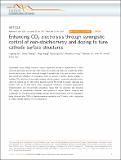Files in this item
Enhancing CO2 electrolysis through synergistic control of non-stoichiometry and doping to tune cathode surface structures
Item metadata
| dc.contributor.author | Ye, Lingting | |
| dc.contributor.author | Zhang, Minyi | |
| dc.contributor.author | Huang, Ping | |
| dc.contributor.author | Guo, Guocong | |
| dc.contributor.author | Hong, Maochun | |
| dc.contributor.author | Li, Chunsen | |
| dc.contributor.author | Irvine, John T. S. | |
| dc.contributor.author | Xie, Kui | |
| dc.date.accessioned | 2017-03-20T16:30:14Z | |
| dc.date.available | 2017-03-20T16:30:14Z | |
| dc.date.issued | 2017-03-16 | |
| dc.identifier | 249430011 | |
| dc.identifier | cb70e3e3-e2bf-441f-9ea2-6f85bcb1953b | |
| dc.identifier | 85015376112 | |
| dc.identifier | 000396399300001 | |
| dc.identifier.citation | Ye , L , Zhang , M , Huang , P , Guo , G , Hong , M , Li , C , Irvine , J T S & Xie , K 2017 , ' Enhancing CO 2 electrolysis through synergistic control of non-stoichiometry and doping to tune cathode surface structures ' , Nature Communications , vol. 8 , 14785 . https://doi.org/10.1038/ncomms14785 | en |
| dc.identifier.issn | 2041-1723 | |
| dc.identifier.other | ORCID: /0000-0002-8394-3359/work/68280884 | |
| dc.identifier.uri | https://hdl.handle.net/10023/10497 | |
| dc.description | K.X. acknowledges Natural Science Foundation of China (91545123) and Natural Science Foundation of Fujian Province (2016J01275) for funding this work. C.L. acknowledges support by the Strategic Priority Research Program of the Chinese Academy of Sciences, Grant No. XDB20000000 and Hundred Talents Program of the Chinese Academy of Sciences. J.T.S.I. acknowledges funding from EPSRC Platform Grant EP/K015540/1 and Royal Society Wolfson Merit Award WRMA 2012/R2. | en |
| dc.description.abstract | Sustainable future energy scenarios require significant efficiency improvements in both electricity generation and storage. High-temperature solid oxide cells, and in particular carbon dioxide electrolysers, afford chemical storage of available electricity that can both stabilize and extend the utilization of renewables. Here we present a double doping strategy to facilitate CO2 reduction at perovskite titanate cathode surfaces, promoting adsorption/activation by making use of redox active dopants such as Mn linked to oxygen vacancies and dopants such as Ni that afford metal nanoparticle exsolution. Combined experimental characterization and first-principle calculations reveal that the adsorbed and activated CO2 adopts an intermediate chemical state between a carbon dioxide molecule and a carbonate ion. The dual doping strategy provides optimal performance with no degradation being observed after 100 h of high-temperature operation and 10 redox cycles, suggesting a reliable cathode material for CO2 electrolysis. | |
| dc.format.extent | 3821696 | |
| dc.language.iso | eng | |
| dc.relation.ispartof | Nature Communications | en |
| dc.subject | QD Chemistry | en |
| dc.subject | E-NDAS | en |
| dc.subject | SDG 7 - Affordable and Clean Energy | en |
| dc.subject.lcc | QD | en |
| dc.title | Enhancing CO2 electrolysis through synergistic control of non-stoichiometry and doping to tune cathode surface structures | en |
| dc.type | Journal article | en |
| dc.contributor.sponsor | EPSRC | en |
| dc.contributor.sponsor | The Royal Society | en |
| dc.contributor.institution | University of St Andrews. School of Chemistry | en |
| dc.contributor.institution | University of St Andrews. EaSTCHEM | en |
| dc.identifier.doi | 10.1038/ncomms14785 | |
| dc.description.status | Peer reviewed | en |
| dc.identifier.grantnumber | EP/K015540/1 | en |
| dc.identifier.grantnumber | WRMA 2012/R2 | en |
This item appears in the following Collection(s)
Items in the St Andrews Research Repository are protected by copyright, with all rights reserved, unless otherwise indicated.

